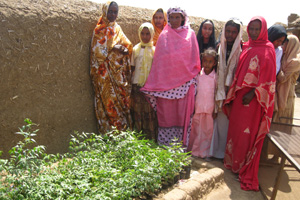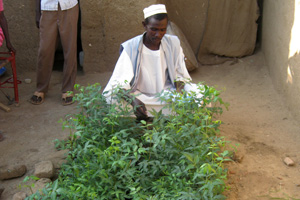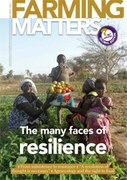Butana is a dry plateau in northern Sudan, east of the river Nile. Covering 65,000 square kilometres, less than 10% can be described as ‘woodland’ in the vaguest sense of the word, and even these trees are disappearing rapidly. The Butana Integrated Rural Development Project began in 2008 with the aim of supporting the livelihoods of poor family farmers by strengthening their resilience in the face of recurrent droughts. And improving tree cover was a key means of achieving this.
Since time immemorial, farmers have recognised the role of trees in maintaining, restoring and improving land productivity. But trees are still being cut for fuel and posts, land is converted to agriculture, and natural regeneration is reduced by overgrazing, bush fires and droughts.
To overcome this, tree planting has been promoted in Sudan and nurseries established, especially after the severe droughts of the 1980s.
From centralised to localised nurseries

In the past, the National Forests Corporation of Sudan and its partners established large centralised nurseries administered and supported by the government or external donors. Local communities played no significant role. The influx of international non-governmental organisations in the 1980s then saw a move towards smaller community nurseries with the voluntary involvement of local people. The hope was to improve effectiveness and efficiency, lessen the financial burden, and secure sustainability after the withdrawal of external support. In practice, however, many community nurseries faced difficulties soon after projects ended, often due to inadequate attention to issues of local ownership and sustainability. Lack of water, polythene bags and good soil were common, but the biggest problem was that community members were increasingly reluctant to provide free labour for tending seedlings.
Adapting nurseries to local needs
Native and exotic trees in Butana
Butana’s natural vegetation is dominated by Acacia tortilis subsp. tortilis (samur) and subsp raddiana (sayal), and other acacias, notably Acacia ehrenbergiana (salam), Acacia mellifera (kitir), Acacia nilotica (sunut), Acacia nubica (laout), and Acacia seyal (taleh). Native acacias are multipurpose, providing fodder, food, fibre, fuel and construction wood, shelter from the sun and wind, and fixing nitrogen. The most common exotic trees are Azadirachta indica (neem) and Albizia lebbeck (dign al-basha) planted around compounds and as street trees, but few fruit trees due to water scarcity and poor soils.
Development workers then introduced new ideas. One was to bring in a business element with the aim of making farmers more responsible and for nurseries to at least recover their costs. Community based organisations had to purchase seedlings directly or urge their members to do so, instead of receiving them for free.
In El Regail in Gedaref State for example, one organisation purchased 800 seedlings from the neighbouring village in 2013 for planting in home compounds and women’s communal vegetable gardens.
In the late 1990s, the ‘home nursery’ emerged from the Kordofan region as another working model. Community members were given portable chicken wire cages to protect seedlings from poultry and other animals. Two metres long and a metre wide, they were kept inside home compounds rather than in fields further away. Many women also appreciated the cages for another unexpected service – as drying racks after washing the dishes!
In Butana, home nurseries turned out to be cheap and effective. Their capacity of 50 to 200 seedlings is manageable for a family, and being inside the compound, all household members help tend the seedlings. Importantly, they rely solely on the use of local resources. Rather than polythene bags, tin cans, plastic bottles and empty sacks are used, and some proved much more durable. For irrigation, people used water that commonly leaks from clay pots of drinking water found in almost every rural household.
The Butana Integrated Rural Development Project was based on this model. It ran seven training courses in 2010-11, in Gedaref and Kassala (Eastern State), Gezira and Khartoum (Central State) and River Nile (Northern State), training 58 women and 97 men on nursery practices, seed collection, extraction and storage, sowing, raising seedlings, protection and outplanting.
Mr Adlan
The poorest people depend on trees
Four types of ‘interest group’ were established in Butana – forestry, agriculture, livestock and rangelands – to help communities organise themselves depending on their needs and to improve their effective participation. Of these groups, forestry had the highest participation of the poorest households (84%, with 67-71% in the other groups), and the highest number of women members (54%, with 27-43% in the other groups). This showed a strong correlation between trees, women and poverty. Poor female-headed households acknowledge the importance of trees that provide fuel, poles, food, fodder, fibres and medicines that they could not otherwise afford to buy.
Mr Adlan is considered a wise man, respected by his community in Wad Hirz Allah. Married and with eight children, Mr Adlan is a family farmer who used to rely on variable harvests of sorghum and okra. Four of his children are enrolled in primary or secondary schools, and to pay the fees he would often have to travel far from home to seek paid work. But then, Mr Adlan was elected by the village development committee to head the ‘forestry interest group’, and became one of the first people to receive training in community nursery management. And that changed his life and that of his family
In Gezira State where Mr Adlan lives, 60% of the land is rangeland, 27% is cultivated, 10% is woodland and the rest is bare ground. Tree density in Butana woodland varies from 155 to as few as 55 trees per hectare.
Native trees like Acacia seyal are valued as a source of high quality forage especially during the dry season. However, Mr Adlan was quick to note that most farmers continue to remove trees from their farmland because of the belief that they attract birds that eat their crops. Trees are cut for fuel and construction, but cultivation is the most widespread and destructive reason.
Mr Adlan and his family established a tree nursery. They were given a metal cage, seed and polythene bags. They provided the soil, water, a watering can and lots of care and attention, and produced 240 seedlings in the first three months. Mostly neem for planting as shade trees, they distributed 193 seedlings freely to their neighbours and the local school to increase environmental awareness and to gain public confidence and support.
The remaining 47 seedlings were sold at 4 SDG each, earning a total of 188 SDG (almost US$100). With no more polythene bags, they turned to re-using old tins, bottles and sacks, and used waste water for irrigation. And thanks to his training, Mr Adlan had the skills to collect and extract seeds from the trees around him.
Mr Adlan then trained six interested villagers. Mr Saeed had an old tree in his compound, so Mr Adlan advised him to hang the cage from a branch so that the sheep and goats he also raised would not eat the seedlings.
In 2012, the villagers raised and planted 688 seedlings in and around the village. With the help of the Butana project and the forestry interest group, Mr Adlan also encouraged farmers to enrich the tree cover in and around their fields and compounds.
Home nurseries as a business

Traditionally, rural communities considered trees and range resources a gift of nature. In the 1980s, seedlings became a ‘gift of NGOs’ that further encouraged the notion that they had no associated cost. Now the situation is changing thanks to awareness campaigns and ongoing training, and a deeper understanding of community needs.
For example, the demand for fruit trees and ornamental plants is now being met thanks to specific training from the Department of Horticulture. Mr Adlan was one of the beneficiaries, and of the next batch of 120 seedlings he raised following his return, half were lemon trees. In demand by local communities, Mr Adlan soon found buyers in three neighbouring villages.
Two years later, the Adlan family moved house to a bigger site and one that was also closer to a water supply so they could expand what was becoming a lucrative business. After relying on rented donkey carts, Mr Adlan saved and bought his own cart to deliver seedlings to other villages and to bring water for the nursery and for domestic use.
Impact
Of 155 community members trained by the Butana project, 70% of them established their own nurseries. When asked why, they say that the money that they make from selling seedlings was a strong reason, even in the face of water scarcity. In Gezira State alone in 2013, 30 nurseries produced 4000 seedlings of which half were sold for a total of more than US$1000.
There are also positive environmental impacts. in Kassala State, a total of 58 km of Acacia seyal windbreaks were established in 2013 on more than 600 hectares of previously treeless farmland, directly benefitting 291 farming households. Besides protection of crops and soil against wind, the trees also provide shade, dry season fodder, soil improvement from nitrogen fixation as well as valuable fuelwood.
Experience with rural development projects that rely on community participation shows that it is very hard to sustain activities based on voluntary contributions with few tangible returns. Here it became evident to start with individual champions such as Mr Adlan, and a manageable size of activity. This, in addition to developing home nurseries as a business, has improved community ownership of such projects. Given the success seen with this work, future projects could benefit from replicating or adapting this approach.
Mohammed El Hassan Ali
Mohammed El Hassan Ali is the Natural Resource Management Officer for the Butana Integrated Rural Development Project (BIRDP), Sudan.
Email: mohammedelhassan44@yahoo.com

